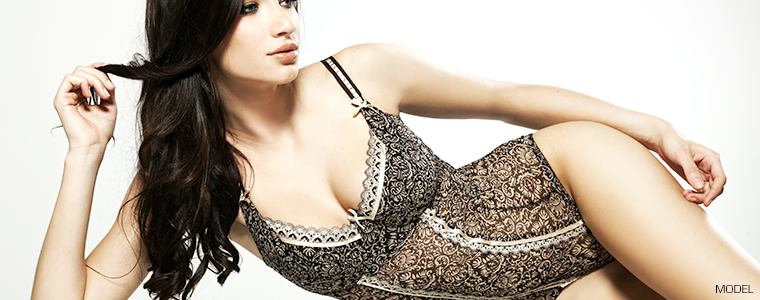Breast Revision

Breast revision surgery is performed to correct a complication or dissatisfaction resulting from a previous breast surgery. Even at the hands of the most skilled and qualified breast augmentation surgeon, the need for breast revision surgery may arise. Depending on the circumstances, breast revision surgery may involve breast implant removal and/or replacement. During your consultation for breast revision surgery, your surgeon will assess your concerns and determine the best technique to meet your needs.
Common Reasons for Breast Revision Surgery
The following are some of the most common reasons for breast revision surgery:
Bottoming Out
Bottoming out occurs when the breast implant descends below the breast crease after surgery, causing the breast to lose volume in the upper portion. This complication can also cause the nipple to appear too high on the breast. Your surgeon may perform a capsulorrhaphy, which involves sutures in the lower portion of the breast that will elevate the breast implant to the correct position.
Capsular Contracture
Capsular contracture is one of the most common breast augmentation complications. This complication occurs when the scar tissue surrounding the implant hardens excessively, squeezing the implant and producing discomfort and/or an unnatural breast appearance. This complication usually requires removal of the scar tissue. The implants themselves are not usually removed or replaced unless they are defective.
Double Bubble Deformity
Double bubble deformity can occur when the breast implant slides below the breast crease and creates a second area of fullness, or “bubble,” on the bottom of the breast. To correct this complication, your surgeon may need to perform a breast lift as well as a secondary augmentation.
Malposition of Anatomical Implants
Anatomical implants, commonly called “teardrop-shaped” implants, are often desired because they have a very natural shape that creates more fullness in the lower portion of the breasts and taper upward. Although rare, these implants can cause the breasts to appear oblong or misshapen if they are placed incorrectly or rotate within the breast pocket. During breast revision surgery, the malposed implants may be replaced with round implants or placed back into their correct position.
Positioning Issues
When breast implants are placed too closely together, too far apart, or when they do not “settle” into the correct position once the final breast augmentation results develop, the solution may be to completely remove the implants and possibly replace them if the patient desires. Another option is to manipulate the tissues that support the implants to move them into the correct position.
Ruptured Implant
The rate of implant rupture has decreased significantly over the last few years. Rupture can occur with either silicone or saline implants. Rupture of a saline implant will result in an obvious deflation of the breast, whereas silicone implant rupture generally requires an MRI screening to detect. During breast revision surgery for a ruptured implant, your surgeon will remove the affected implant, irrigate the breast pocket, and replace the implant.
Size Change
The desire to change implant size is the most common reason for breast revision surgery. Usually, the patient desires to have larger breasts than her primary augmentation achieved. During your breast revision consultation, your surgeon will assess your chest width to determine if larger implants will safely and effectively achieve the look you desire.
Symmastia
Symmastia occurs when one or both breast implants are positioned too close to the midline of the chest and the two breasts become connected at the cleavage. This complication is characterized by the skin over the sternum tenting from one breast to the other or the two breast implants touching in the middle. The nipples may also point outward. During breast revision surgery for symmastia, the breast pocket is manipulated in order to correctly position the implants. The connection at the midline is also corrected, resulting in a more natural breast appearance.

